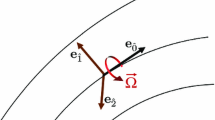Abstract
We discuss the theoretical and experimental foundations of the hypothesis on the origin of the magnetic fields of the Earth and other astrophysical objects, put forward in the early twentieth century by Sutherland and later by Einstein. According to this hypothesis, the electric charges of an electron and a proton are slightly different in absolute values, which, due to the rotation of the Earth (or another astronomical object), leads to emergence of a magnetic field. Terrestrial experiments aimed at determining the difference in the electric charges of an electron and a proton are discussed. The Sutherland–Einstein hypothesis is theoretically justified within the framework of two versions of the geometric approach: (1) in a simplified version of the 6-dimensional Kaluza–Klein theory, and (2) in the framework of the 5-dimensional Kaluza theory with scalarism, as well as in the framework of the relational approach.
Similar content being viewed by others
References
A. Schuster, J. Geophys. Res. 1, 1 (1896).
P. N. Lebedev, “The magnetometrical investigation of rotating bodies”, in Selected Works, Ed. by A. K. Timiryazev (Gostechizdat, Moscow, 1949, in Russian).
H. A. Wilson, Proc. Roy. Soc. 104, 451 (1923).
P. M. S. Blackett, Nature 159, 658 (1947).
E. V. Stupochenko, Doklady Akademii Nauk SSSR 62(4), 477 (1948) [in Russian].
B. M. Yanovskij, Earth’s magnetism (Leningrad University Press, Leningrad, 1978, in Russian).
J. Larmor, Rep. Brit. Ass. Advmt. Sci. 4, 159 (1919).
W. M. Elsasser, Phys. Rev. 55, 489 (1939).
Ya. I. Frenkel, Izv. AN USSR Ser. Fiz. 11, 6 (1947) [in Russian].
T. Rikitake, Electromagnetism and the Earth’s Interior (Elsevier, Amsterdam, 1966).
E. N. Parker, Conversations on Electric and Magnetic Fields in the Cosmos (Princeton Univ. Press, Princeton, 2007).
Ya. B. Zeldovich, A. A. Ruzmaikin, and D. D. Sokoloff, The Almighty Chance (World Scientific, Singapore, 1990).
S. A. Arseniev, “Theoretical modeling of the main magnetic field of the Earth and the planets”, Aktualnye problemy gumanitarnykh i estestvennykh nauk, 4(2), 313 (2015) [in Russian].
V. V. Kuznetsov, Introduction to Hot Earth Physics (Petropavlovsk-Kamchatsky, KamSU, 2008, in Russian).
V. I. Grigoriev, E. V. Grigoriev, and V. S. Rostovskij, Baroelectric effect and electromagnetic fields of planets and stars (PHYSMATLIT, Moscow, 2003, in Russian).
W. Sutherland, Nature 63, 205 (1900).
W. Sutherland, Terr. Mag. Atmos. Electr. 8, 49 (1903).
W. Sutherland, Terr. Mag. Atmos. Electr. 9, 167 (1904).
W. Sutherland, Terr. Mag. Atmos. Electr. 13, 155 (1908).
W. Sutherland, Terr. Mag. Planet Sci. 5, 73 (1900).
D. Brunt, Astron. Nachrichten, 196, 169 (1913).
V. W. Hughes, “The Lyttleton-Bondi universe and charge equality”, in Gravitation and Relativity, Ed. H.-Y. Chiu and W. F. Hoffmann (W. A. Benijamin Inc., New York–Amsterdam, 1964)
A. Piccard and E. Kessler, Arch. Sci. Phys. Nat. 7, 340 (1925).
G. Bressi, G. Carugno, F. Della Valle, G. Galeazzi, G. Ruoso, and G. Sartori, Phys. Rev. A 83, 052101 (2011); arXiv: 1102.2766.
J. Schwinger, Einstein’s Legacy: The Unity of Space and Time (New York, Scientific American Library, 1986).
Yu. S. Vladimirov, Moscow University Physics Bulletin 2, 6 (2000)
Yu. S. Vladimirov, Geometro-physics (BINOM Publishing, Moscow, 2008, in Russian).
Yu. S. Vladimirov, Metaphysics and Fundamental Physics. Part 2 (LENAND Publ., Moscow, 2017, in Russian).
Yu. S. Vladimirov, Relational picture of the world. Book 1. Relational concept of geometry and classical physics (LENAND Publ., Moscow, 2020, in Russian).
H. Weyl, Space, Time, Matter (Dover Publ., Mineola, 1952).
E. Schmutzer, Relativistische Physik (Ernst. Publication, Leipzig, Teubner, 1968).
Yu. S. Vladimirov and S. V. Bolokhov, Space, Time and Fundamental Interactions 2(19), 27 (2016) [in Russian].
I. A. Babenko, Metafizika 4 (38), 166 (2020) [in Russian].
Yu. S. Vladimirov, S. V. Bolokhov, and I. A. Babenko, Grav. Cosmol. 24, 139 (2018).
R. A. Millikan, The Electron (Chicago and London, Tne University of Chicago Press, 1917).
J. C. Zorn, G. E. Chamberlain, and V. W. Hughes, Phys. Rev. 129, 25 (1963).
J. G. King, Phys. Rev. Lett. 5, 562 (1960).
V. W. Hughes, Phys. Rev. 105, 170 (1957).
A. Einstein, “Prinzipielles zur allgemeinen Relativitätstheorie”, Ann. Phys. 55, 241 (1918)
A. S. Eddington, Fundamental theory (New York, Cambridge Press, 1946).
Author information
Authors and Affiliations
Corresponding author
Rights and permissions
About this article
Cite this article
Babenko, I.A., Vladimirov, Y.S. The Sutherland–Einstein Hypothesis on the Origin of Magnetic Fields of Astropysical Objects. Gravit. Cosmol. 27, 105–112 (2021). https://doi.org/10.1134/S0202289321020043
Received:
Revised:
Accepted:
Published:
Issue Date:
DOI: https://doi.org/10.1134/S0202289321020043



